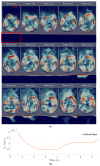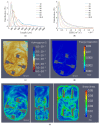Characterization of the Aeration and Hydrodynamics in Vertical-Wheel™ Bioreactors
- PMID: 36004911
- PMCID: PMC9405225
- DOI: 10.3390/bioengineering9080386
Characterization of the Aeration and Hydrodynamics in Vertical-Wheel™ Bioreactors
Abstract
In this work, the oxygen transport and hydrodynamic flow of the PBS Vertical-Wheel MINI™ 0.1 bioreactor were characterized using experimental data and computational fluid dynamics simulations. Data acquired from spectroscopy-based oxygenation measurements was compared with data obtained from 3D simulations with a rigid-lid approximation and LES-WALE turbulence modeling, using the open-source software OpenFOAM-8. The mass transfer coefficients were determined for a range of stirring speeds between 10 and 100 rpm and for working volumes between 60 and 100 mL. Additionally, boundary condition, mesh refinement, and temperature variation studies were performed. Lastly, cell size, energy dissipation rate, and shear stress fields were calculated to determine optimal hydrodynamic conditions for culture. The experimental results demonstrate that the kL can be predicted using Sh=1.68Re0.551Sc13G1.18, with a mean absolute error of 2.08%. Using the simulations and a correction factor of 0.473, the expression can be correlated to provide equally valid results. To directly obtain them from simulations, a partial slip boundary condition can be tuned, ensuring better near-surface velocity profiles or, alternatively, by deeply refining the mesh. Temperature variation studies support the use of this correlation for temperatures up to 37 °C by using a Schmidt exponent of 1/3. Finally, the flow was characterized as transitional with diverse mixing mechanisms that ensure homogeneity and suspension quality, and the results obtained are in agreement with previous studies that employed RANS models. Overall, this work provides new data regarding oxygen mass transfer and hydrodynamics in the Vertical-Wheel bioreactor, as well as new insights for air-water mass transfer modeling in systems with low interface deformation, and a computational model that can be used for further studies.
Keywords: Kolmogorov; LES; OpenFOAM; Sherwood; WALE; energy dissipation rate; homogeneity; human induced pluripotent stem cell; mass transfer; mesh refinement; optimization; oxygenation; partial slip; rigid-lid; shear stress; stirred suspension bioreactor; vertical-wheel.
Conflict of interest statement
The authors declare no conflict of interest.
Figures
















References
-
- Borys B.S., Dang T., So T., Rohani L., Revay T., Walsh T., Thompson M., Argiropoulos B., Rancourt D.E., Jung S., et al. Overcoming bioprocess bottlenecks in the large-scale expansion of high-quality hiPSC aggregates in vertical-wheel stirred suspension bioreactors. Stem Cell Res. Ther. 2021;12:1–19. doi: 10.1186/s13287-020-02109-4. - DOI - PMC - PubMed
-
- Rodrigues C.A., Silva T.P., Nogueira D.E., Fernandes T.G., Hashimura Y., Wesselschmidt R., Diogo M.M., Lee B., Cabral J.M. Scalable culture of human induced pluripotent cells on microcarriers under xeno-free conditions using single-use vertical-wheel™ bioreactors. J. Chem. Technol. Biotechnol. 2018;93:3597–3606. doi: 10.1002/jctb.5738. - DOI
-
- Nogueira D.E., Rodrigues C.A., Carvalho M.S., Miranda C.C., Hashimura Y., Jung S., Lee B., Cabral J. Strategies for the expansion of human induced pluripotent stem cells as aggregates in single-use Vertical-Wheel™ bioreactors. J. Biol. Eng. 2019;13:1–14. doi: 10.1186/s13036-019-0204-1. - DOI - PMC - PubMed
-
- de Sousa Pinto D., Bandeiras C., de Almeida Fuzeta M., Rodrigues C.A., Jung S., Hashimura Y., Tseng R.J., Milligan W., Lee B., Ferreira F.C., et al. Scalable manufacturing of human mesenchymal stromal cells in the vertical-wheel bioreactor system: An experimental and economic approach. Biotechnol. J. 2019;14:1800716. doi: 10.1002/biot.201800716. - DOI - PubMed
Grants and funding
LinkOut - more resources
Full Text Sources

